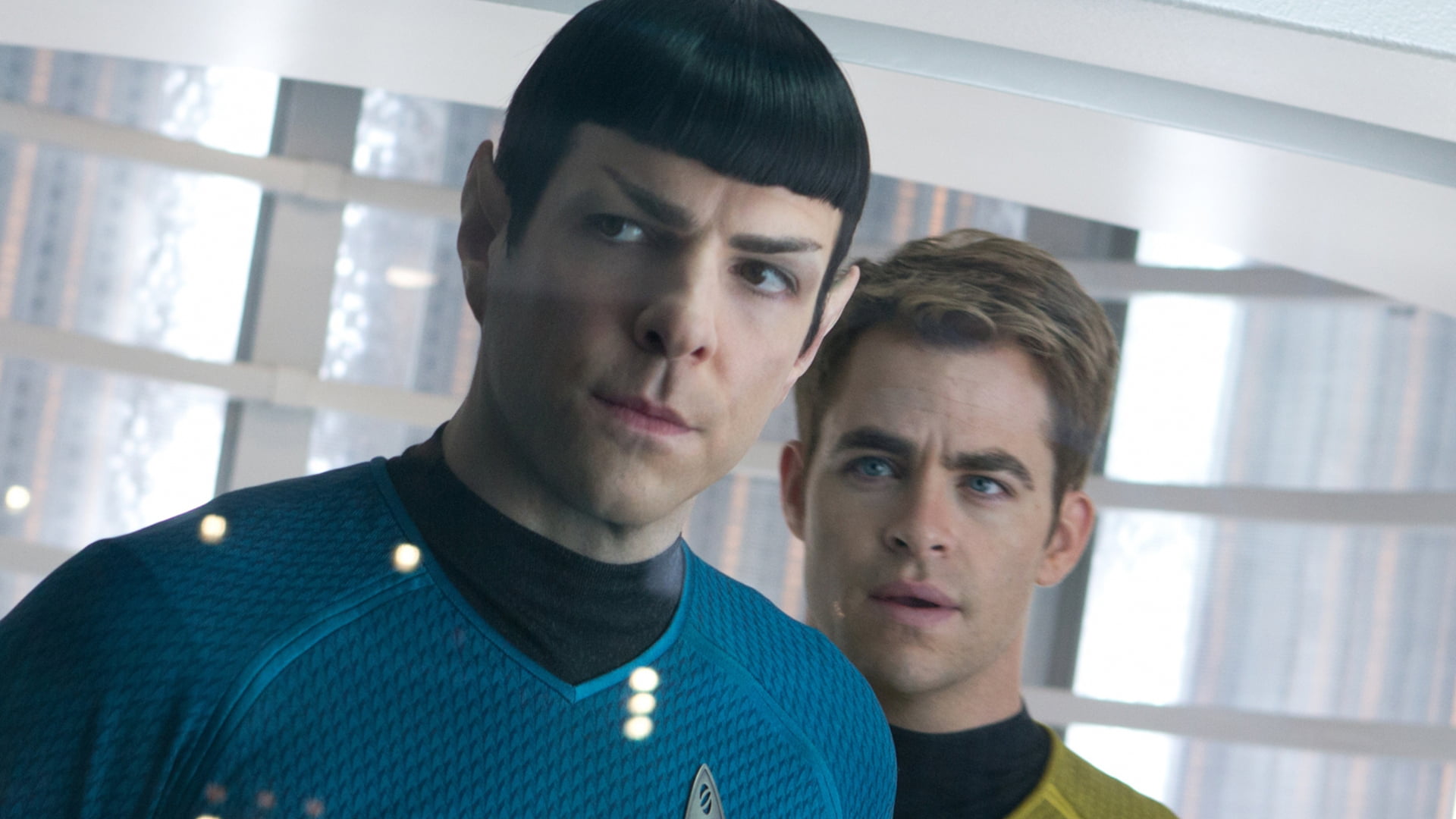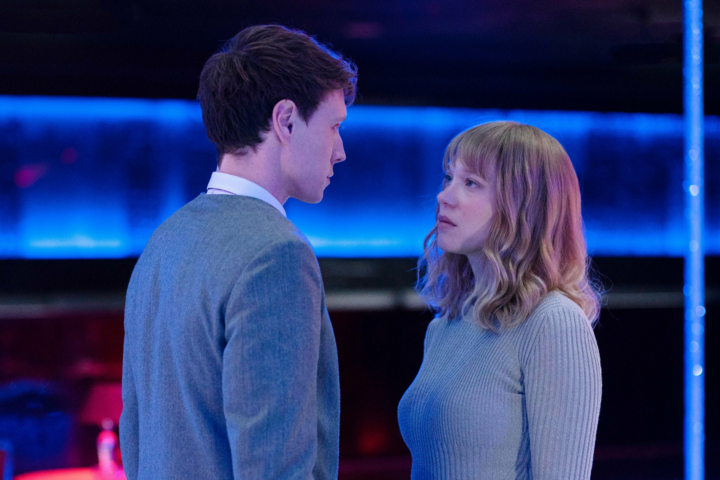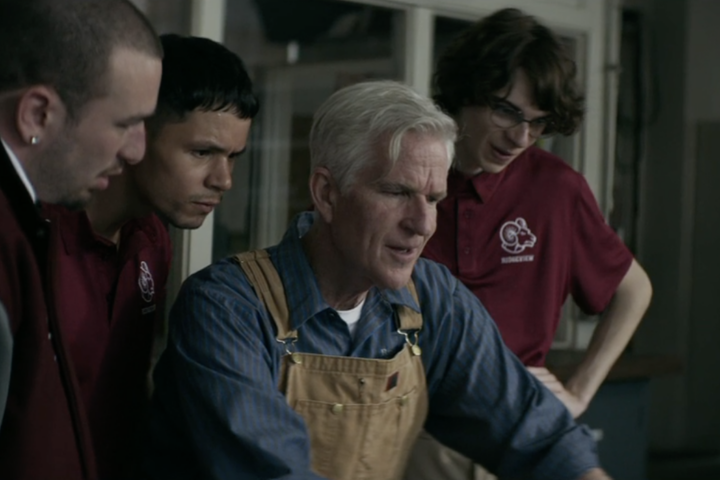Note: This review contains plot spoilers.
A mostly disappointing sequel to the gleaming 2009 series reboot, Star Trek Into Darkness is a movie that gives us a recycled villain, by-the-numbers directing and nothing new from the J.J. Abrams canon. It’s serviceable and enlivened by strong performances and an exciting climax, but largely plays like a perfunctory rehash.
The picture opens on a volcanic planet as Commander Jim Kirk (Chris Pine) and Lieutenant “Bones” McCoy (Karl Urban) flee a tribe of painted white natives before rescuing First Officer Spock (Zachary Quinto) from an erupting volcano. This time out there’s romantic squabbling between Spock and Lieutenant Uhura (Zoe Saldana, terrific) and upon returning to 23rd Century London, Kirk and Spock are reprimanded for protocol by Commander Pike (Bruce Greenwood).
The screenplay immediately draws human-Vulcan distinctions between the pair as Spock’s truth telling causes Kirk to be stripped of Enterprise command and Spock transferred. The same Vulcan empathy issues have toppled his relationship with Uhura, but for Spock the mysteries of human feeling are, at least for now, out of reach.
Enter John Harrison (Benedict Cumberbatch, splendid), a disgruntled former Starfleet company man with an axe to grind, who detonates an explosion destroying headquarters and allowing the film to intimate, as did the much inferior Iron Man 3, an obvious modern parallel.
Kirk is handily reinstated as captain of Enterprise and assigned to the dangerous Klingon planet Kronos, where Harrison—a.k.a. Khan, borrowed liberally from 1982’s Ricardo Montalban starrer Star Trek II: The Wrath of Khan—is reportedly laying in wait. Harrison, played with icy cool menace by the accomplished Cumberbatch, leads a sleeping army of 72 cryogenically frozen (into torpedo heads, no less) soldiers as programmed weapons of mass destruction. Or something like that.
Meanwhile, Lieutenant “Scotty” (Simon Pegg) resigns during a debate with Kirk over onboard weapons (i.e., whether to capture or merely kill their nemesis, shades of Osama bin Laden). But such would-be philosophical musings in the screenplay by Roberto Orci, Alex Kurtzman and Damon Lindelof (who explored such deep think ponderings in Ridley Scott’s Prometheus) are jettisoned in favor of traditional action climaxes, including an effective sequence where Kirk and Khan speed through a debris field toward a door that doesn’t seem to want to open.
As rote as most of Star Trek Into Darkness seems, I’d be lying if I claimed the final uptake, featuring an Enterprise power outage and spectacular crash of Khan’s Vengeance into the San Francisco Bay, leading to a chase above the city allowing Saldana to display her Avatar pluck, didn’t grab me—too little, too late.
Savvy filmgoers will see the final crisis and resolution coming midway, but when those predicted closing scenes unspool, a maddeningly elliptical narrative omission feels jarring—we’re in the middle of an action scene and then someone is miraculously cured.
While Pegg and Anton Yelchin as Ensign Chekov run the hammiest accent Olympics, the understated John Cho returns as Lieutenant Sulu and Leonard Nimoy turns up in expositional cameo to remind us that our villain is borrowed from the 1982 picture. The movie also introduces an appealing Alice Eve (She’s Out of My League) as Dr. Carol Marcus, science officer and daughter of corrupt Admiral Alexander Marcus (Peter Weller, a welcome presence).
Much of the film rests on the authority of Pine, who showed dramatic flair in last year’s People Like Us, here managing the neat trick of making Jim Kirk a swaggering cock-of-the-walk but with a vulnerability ready to uncork, which he does, in a late scene with Quinto, equally effective when Spock’s Vulcan detachment gives way to his humanity. For all of the hardware and effects on display in Star Trek Into Darkness, it’s this bro-mantic bond that delivers in a scene of sacrifice, loyalty and real sadness.
It’s particularly liberating to see Quinto, who came out publicly in 2011, don the action-hero goods in a climactic combat with Cumberbatch, the rare example of a gay actor driving a testosterone fueled showdown in a summer tentpole picture, and however unintended, the picture’s most progressive, new idea.
While Star Trek Into Darkness may do the trick for franchise fans with its sleek, workman like action scenes and capable villain, there’s a rudimentary vibe informing the entire picture that can’t be shaken.




Finally saw the movie at the IMAX yesterday. Aside from the ovroaeld of being in the front row seats, I really enjoyed it. Being a long time trekker, I think they did a good job with this “reboot” of the franchise. The characters played off each other really well, the action was standard sci-fi but well done, great CGI, and it was fun! Sure, I had some niggles too. They played a little fast and loose with the tech. Transporting onto a ship in warp light years away? C’mon Also, what looked like factory space on board the ship(s) and having a standard push/lock door on an ice planet (with a little ewok gnome, but that is another story) seemed a bit incongruous. Also, have Spock “Prime” (is that like Optimus?) come in an save the day like Gandalf was a bit of a crutch. I’m not sure yet how I feel about Spock and Uhura being an item too. I do like how Abrams kind of gave things a bit of a “Galactica” look when shooting the space sequences, though not so much that it was uber obvious. All in all, worth seeing in the theater, esp. in IMAX, and a good start to a hopefully reinvigorated series. Let’s face it, these guys will be going to Star Trek conventions for the rest of their lives!